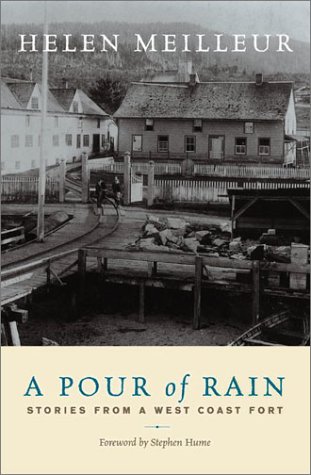Helen MEILLEUR
A Pour of Rain
Stories from a West Coast Fort
 Daughter of Robert Boyd Young and Eva Ina Young, Helen Meilleur was born in Port Simpson,
B.C., in 1910 where she grew up and where she developed a keen interest in the history of the north coast. She was
educated in a one-room school there and helped in her father's general store. Later she went to the University of
British Columbia and to business school. After five years of teaching she turned her hand to a wide assortment of jobs
which she fells have been most instructive and educational, not the least of which was as a wife, and mother of five.
Mrs Meilleur started writing in 1967 and in that year won the Indiana University Writers' Conference scholasrship for
non-fiction. Helen Meilleur is now retired and lives in Bedwell Bay, British Columbia in Canada.
Daughter of Robert Boyd Young and Eva Ina Young, Helen Meilleur was born in Port Simpson,
B.C., in 1910 where she grew up and where she developed a keen interest in the history of the north coast. She was
educated in a one-room school there and helped in her father's general store. Later she went to the University of
British Columbia and to business school. After five years of teaching she turned her hand to a wide assortment of jobs
which she fells have been most instructive and educational, not the least of which was as a wife, and mother of five.
Mrs Meilleur started writing in 1967 and in that year won the Indiana University Writers' Conference scholasrship for
non-fiction. Helen Meilleur is now retired and lives in Bedwell Bay, British Columbia in Canada.
By delving into the Hudson's Bay records and from her voluminous reading and research, the author has reconstructed a
picture of life in the then named Fort Simpson which was at one time the most important Fort settlement on the west
coast.
According to the company factors' logbooks, which were not limited solely to noting trading transactions, life at the
Fort was anything but dull. Indian attacks were not unheard of and squabbles between tribes were a frequent occurrence
often taking place right outside the Fort walls. Visitors came often and included gold-seekers, missionaries,
dignitaries and even royalty on one occasion. Within the walls the daily records noted the success or faillure of the
fort garden, the allotment of alcohol for special occasions and sickness and death of Fort personnel.
In her charming style the author brings the Fort alive with its characters and day to day occurrences. Skilfully
interwoven with these stories are the author's own recollections of Port Simpson in the early 1900's. A Pour of Rain
is a delightful personal memoir and a well-researched and much needed history of a West Coast fort community.
__________________
Designed and printed in Canada by
MORRIS PRINTING COMPANY LTD
Victoria, British Columbia.
Synopsis:
In the small town of Port Simpson in British Columbia, where Helen Meilleur grew up in the 1920s,
she witnessed such exciting events as Indian attacks, gold prospecting, missionary efforts, and visits from royalty.
She also traveled by steamship to her one-room school on an Indian reservation. Her personal stories, written when she
was 70 years old and combined with painstaking research and dozens of photographs, bring forth a remarkable history of
this coastal community.

Auteur Meilleur, Helen, 1910-
Titre A pour of rain / Helen Meilleur.
Sujets Meilleur, Helen, 1910- --Enfance et jeunesse.
Compagnie de la Baie d'Hudson--Histoire.
Comptoirs (Établissements de
commerce)--Colombie-Britannique--
Port Simpson--Histoire.
Indiens d'Amérique--Amérique du
Nord--Port Simpson, Région de
(C.-B.)--Histoire. * Port Simpson (C.-B.)--Histoire.
Éditeur Vancouver : Raincoast Books, 2001.
Cote FC 3849 P8392 M513 2001 Bibliothèque générale
Helen Meilleur grew up in Port Simpson (north of Prince Rupert) during
the first half of the last century. In her book A Pour of Rain she tells the story of her family's life in
that community. Plus she interweaves her own story with the history of the Hudson's Bay Post in the area going back
to the early 1800's. The book was first published over 20 years ago and has now been re issued by Raincoast
Books. Hear some of my conversation with Helen
Meilleur and a couple of readings from her book.
From A Pour of Rain, by Helen Meilleur, 1980. "Stories from a West Coast Fort." from the log book of
Fort Simpson.
Early life, in a fur trading fort.
The fur trade was now centered around forts built by the trading companies.
Circa 1836...
The Indian's keep stealing the pickets!
Pickets were the first concern of the blacksmith's axes and a prime concern of all Fort Simpson's personnel until
the stockades were abandoned in the latter 1800's. You might think that when squared logs up to two feet across were
planted in the earth, with crosspieces and braces, they would be permanent.
But no, those huge stockade pieces were as impermanent as willow wands in the face of their enemies. The walls of
Jericho won everlasting fame because they tumbled once but the stockades of Fort Simpson were in a constant state of
tumbling.
Rain, rain and more rain.
The most insidious enemy of the pickets was rain. In Port Simpson, rain not only "falls on the place beneath,"
it also washes over the ground and settles in a quagmire under the ground. In the low-lying areas of the fort, the
footings of posts could rot in two years, toppling their twenty feet of solid height.
Storms, vicious enough to flatten a section of pickets, occurred indiscriminately throughout the year but the
extreme tides that came ravening ashore, belonged to the equinoxes. When they were blown inland by gales, they lashed
at the stockades, hurling pickets and crosspieces out to sea.
The Indians stole the squared logs regularly. They needed them for building purposes and, more urgently, for
firewood. They had little sense of future and other than storing food, no instinct whatever for preparing for the
winter. Even in my day, no one went out from the village for wood until the weather turned unbearably cold. Then, what
they brought back was green and water soaked and produced only smoke when it could be induced to burn at all.
Naturally, they regarded the Hudson's Bay stockade and garden fence (built of only slightly shorter pickets) as the
Great Spirit's answer to their cold misery.
Stealing the potatos.
During the summer they had no need to steal the pickets. Then they merely pushed them down so they could gain entry
to the garden to dig Hudson's Bay potatoes which the Great Spirit had also supplied against their hunger. They were
adept at grabbing seagull eggs from the nest and making off before the gull mother could attack, so it is no wonder
that their raids of the pickets were so successful. Hardly had a fence been completed around the first garden patch
when Mr. Work wrote, January 16, 1836, "...commenced getting short Pickets and ribbons to enclose our Potato field
as we find we are not able to keep the cedar fencing from being destroyed and burnt by the Indians." The change
made little difference to the natives and for the next twenty-two years a succession of journal-keepers wrote
exasperated notes concerning their losses.
The solution: hire Indian watchmen.
Then Mr. McNeill, the Resourceful, commented, "Indians stealing pickets, say fifteen per day," and accepted
the challenge. He hired two Indian watchmen to be responsible for the pickets. The scheme worked as efficiently as
most McNeill devices. The following January he recorded, "We have not as yet lost one garden picket. All former
winters from 200 to 300 were stolen."
| Recherche par Paul Meilleur, de Ste-Adèle QC Mise à jour le 31 mai 2003, par Paul Meilleur, de
Ste-Adèle QC
Retour à la Généalogie
|

|
 Daughter of Robert Boyd Young and Eva Ina Young, Helen Meilleur was born in Port Simpson,
B.C., in 1910 where she grew up and where she developed a keen interest in the history of the north coast. She was
educated in a one-room school there and helped in her father's general store. Later she went to the University of
British Columbia and to business school. After five years of teaching she turned her hand to a wide assortment of jobs
which she fells have been most instructive and educational, not the least of which was as a wife, and mother of five.
Mrs Meilleur started writing in 1967 and in that year won the Indiana University Writers' Conference scholasrship for
non-fiction. Helen Meilleur is now retired and lives in Bedwell Bay, British Columbia in Canada.
Daughter of Robert Boyd Young and Eva Ina Young, Helen Meilleur was born in Port Simpson,
B.C., in 1910 where she grew up and where she developed a keen interest in the history of the north coast. She was
educated in a one-room school there and helped in her father's general store. Later she went to the University of
British Columbia and to business school. After five years of teaching she turned her hand to a wide assortment of jobs
which she fells have been most instructive and educational, not the least of which was as a wife, and mother of five.
Mrs Meilleur started writing in 1967 and in that year won the Indiana University Writers' Conference scholasrship for
non-fiction. Helen Meilleur is now retired and lives in Bedwell Bay, British Columbia in Canada. 
